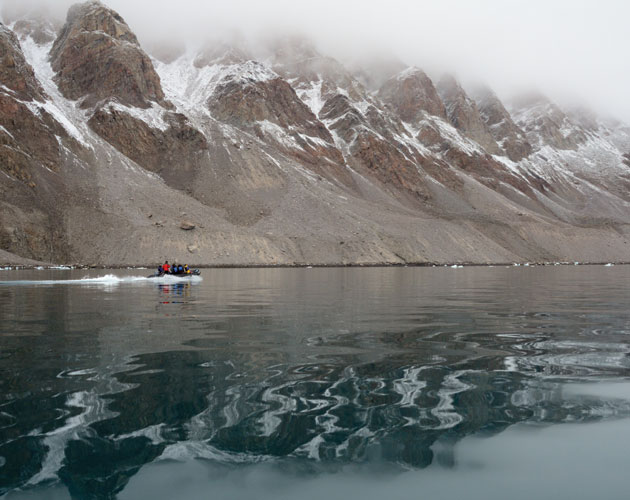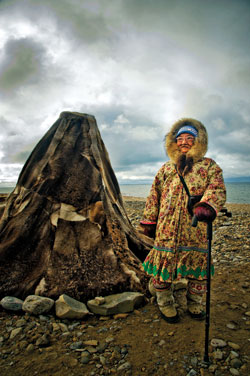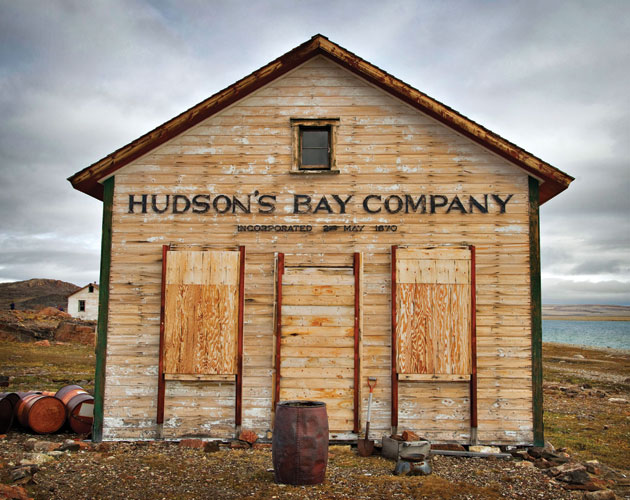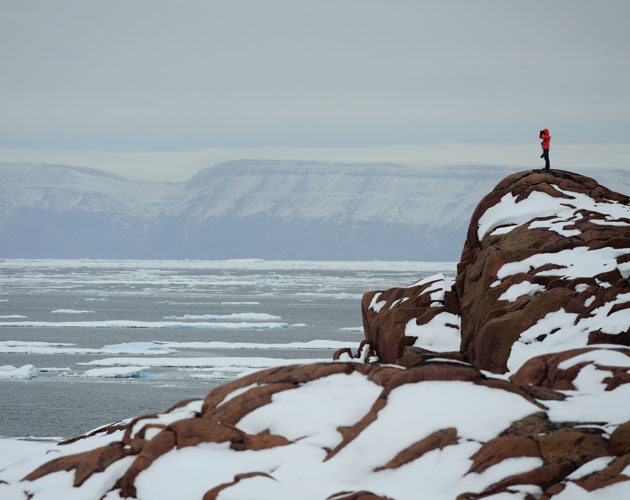Into the Northwest Passage

Zodiac cruising in Cuming Inlet
After six years of searching, one of the lost ships of the doomed 1845 Franklin expedition has been discovered in the Canadian Arctic. Here, Noah Richler follows the fabled route of explorer John Franklin and the unforgettable experience its grandeur brings
After the shock of checking in at five in the morning, the 100-odd passengers joining Adventure Canada’s Into the Northwest Passage fortnight boarded Toronto’s CanJet flight 81 bound for Kangerlussuaq, Greenland.
Aboard the MV Sea Adventurer, constructed for expeditions to remote reaches, we would travel for six days, making stops along the west coast of Greenland before crossing the Davis Strait to Canada, continuing along the north side of Baffin Island and along Lancaster Sound and then through the Bellot Strait past the Boothia Peninsula, the northernmost point of the continental North American land mass, into Queen Maud Gulf and past the estuary of the Coppermine River to Kugluktuk.
That was the plan, anyway – this, the Arctic journey that the fabled English explorer John Franklin sought to travel in 1845 with his ships, HMS Terror and Erebus, before they were locked into the ice, subsequently disappearing and providing Canada one of its great mysteries and foundation myths. A barometer of our excitement, even in the newness of the gentler Greenland Arctic landscape – trees absent, gravel in abundance and hotels and schools made of pre-fabricated containers – everything and anything appeared auspicious.
At the Kangerlussuaq harbour, once an American military base, the Sea Adventurer was visible offshore, while on the muddy beach was the carapace of a derelict barge going nowhere. Its muddy rusted innards open to the elements looked like the fleshless rib cage of some long-deceased whale. And as we would come to see, Inuit and their Thule predecessors imitated exactly the body of a whale when, willing Jonahs, they built their sod houses, brilliantly managing to make home of an incomparably inhospitable land with scant materials, the ribs of whales their two-by-fours.
After a breathtaking passage through the Kangerlussuaq Fiord, the Sea Adventurer entered the rougher waters of the Davis Strait, passengers accustoming to the rolling of the ship, the new sounds of clinking chains and groaning decks, and the shove and shake of waves knocking against the ship’s hull and playing it like a drum. Come 6 a.m., the voice of the trip’s expedition leader, Chris Dolder, making the first of his early (and some very early) morning wake-up calls, could be heard over the ship’s PA. “Good morning, good morning, good morning,” said Dolder, offering up, as he would daily, details of the ship’s position, the plans for the day – weather conditions permitting. And then the only semi-comic warning, “This is not a holiday.”
In Sisimiut, renowned for its kayaks made in the traditional fashion (though using cloth and resins rather than sealskins for the hull), we walked the well-kept town and visited the local co-op for “country food” – whale, seal, Greenland halibut and other hunted prey. Then an Inuk in an exquisite kayak of his own paddled to the side of the ship and demonstrated a series of techniques for rolling in different Northern situations – with his paddle to the side, behind his back or in one hand and even paddling flipped upside-down and underwater for several lengths as a hunter might have to do when faced with otherwise impassable pack ice or a polar bear or both.
But the highlight of the Greenland start to the Northern journey could not but be Ilulissat, where the viewing of icebergs – some as small as a house, others the size of 20 city blocks – is without compare. Beyond the small pretty village, with its restaurants and “butiks” an example of what the settlements of Canada’s own North could one day be, an immaculately maintained boardwalk allows trekkers to reach observation points along the shore without trampling the delicate, spongy muskeg surface of the Greenland Arctic meadow that is in itself a moving landscape.
The vistas are simply unforgettable – on this day, a colossal great sloping bank of an iceberg half a mile long surrounded by lesser infant ones and a crush of shards and floes of ice moving en masse around its base. And then came the shocking realization: the huge iceberg, a mere eighth of it visible above the surface of the water, was itself moving fast enough that the pace was visible to the eye. Occasional booms and cracks were yet more signals that the glacial flow was volatile and dynamic. It was impossible not to sit still in silent reverie.
“It’s like visiting a thousand cathedrals at once,” said one awed passenger.
Along the same stretch of Greenland’s western flank, the Sea Adventurer moored off Qilakitsoq, across the water from a picturesque scattering of houses situated, as if out of a fantasy book, at the base of a heart-shaped mountain rising suddenly out of the sea. In 1972, eight extremely well-preserved mummified bodies of Inuit women and children, dating to approximately 1475, were found here and subsequently moved to the Greenland capital, Nuuk.
Nevertheless, the graves – piles of stones carefully constructed beneath the overhanging face of a large boulder (there is no possibility of digging) – are intensely moving. Their position makes it all too easy to imagine distraught Inuit husbands and fathers, perhaps held up by too much snow or melted ice, returning from the hunt to find their loved ones dead and wanting to honour them with graves in a location where they might gaze for eternity across the water.
Already, the hubbub of excited passengers returning from the Zodiacs to chat over tea or a drink in the ship’s Forward Lounge was sweet. This is made even more pleasant because the passengers who enrol for Adventure Canada tend to be a marvellously self-selecting bunch. They are typically, though not exclusively, boomers with education and experience behind them: geologists, teachers, artists but also, with her charming pre-teen daughter, a Royal Canadian Air Force pilot (who had flown over Adventure Canada ships during reconnaissance flights and thought, “I want to do what they’re doing!”) and a retired Japanese territorial governor.
The Forward Lounge is the ship’s agora, the meeting place where every day passengers gather to discuss their experiences, and the company’s companionable resource staff does their best to make sense of them in casual conversation, in scheduled talks – and, before dinner, in the team’s analysis of ice charts and weather conditions. During our own trip, in mid-August last year, the heaviest accumulation of sea ice in a dozen years was, even early on, threatening the likelihood of the Sea Adventurer achieving its planned itinerary through the historic Northwest Passage.
“Sometimes,” warned Dold-er, “it’s cool to be stuck in pack ice – but only for a little bit of time.”

As if heralding our entrance into Canada, an immense tabular glacier larger than anything we had seen in Greenland waters was situated in the glorious day to the ship’s port. Likely a piece of the Ellesmere ice sheet, its visible eighth stood some 60 metres high, and the ship’s captain, Sergei Nesterov, estimated the flank we were passing to measure more than two nautical miles, the immense and exquisite piece of some 4.6 nautical miles squared in its entirety.
So much, in journeys like these, comes out of the unexpected or even from what might otherwise seem like failure. On another day, after winds had whipped up and made a planned landing at the foot of a glacier foolhardy, a call in hushed tones – a state of awe is a frequent condition – was issued from the bridge: “Polar bear!” came the excited announcement, one having been spotted walking back and forth along the brim of an enormous iceberg in the shape of a top hat. (Later, a first for me, we would spot a polar bear in the middle of lunch, pulling apart the body of a seal, the blood on the floe beside him like the tomato-red stain of an enormous pizza.)
The humbling in the North is permanent. Travelling the Arctic is an exercise in fascinating humility, the ephemeral nature of being human driven home, first of all, by the sheer scale of things massively large but also wondrously small.
For scale works at both ends and, as we would experience time and again, we were taught the fleetingness of our existence not only by spectacular fiords, mountains, cliffs and the ice formations that created them but also by the amazing tenacity of tiny plants finding resilient ways to overcome the extraordinary challenges of Arctic living – and to mark their place with beauty, too.
Landing at a shoal of a beach after dinner one night, we basked in the golden light of the setting sun and the North’s long dusk, passengers strolling the length of a beautiful sandbar at the foot of a gentle rocky bank covered in verdant mossy meadow. The waters of a small meandering brook rippled down towards the beach, past desiccated bones of whale – we were not the first to visit here, by any means – before joining the gently lapping sea. The scene might have been Irish it was so lush, and passengers knelt or lay prostrate to shoot pictures of the precocious and resourceful flowers that, with their single pretty buds, were somehow managing an elegant existence. The passengers seemed, fittingly, to be in positions of prayer. This, as much as the abundant scenery and history, I will not forget.
The other reminders are human. A trip through the Arctic is also a journey through the miracle of human habitat – of, centuries ago, Thule families living in sod houses with their stone foundations, entry tunnels and roofs suspended with whale bones, and then, in this one, Inuit living in settlements such as Pond Inlet. There, in the community centre, with its ice rink and gym (it is the modern equivalent of the qaggiq, the over-sized igloo in which families used to gather), the community offered up a spirited and unforgettable welcome. Elisapee Ootoova, author and a member of the Order of Canada, lit a kudluk, the traditional Inuit lamp that, using wicks made of rolled Arctic grasses to draw a low, broad flame from a puddle of seal oil, once provided light but also heat to igloos during the long nights of winter.
A couple of young Inuit put on a daunting display of Inuit gymnastics, and two young women followed with some first-rate throat singing and ayaya songs. One of the performers, the actor Lamech Kadloo (who would join the ship’s crew, Adventure Canada making a point of having Inuit staff on board), explained the joy of the ayaya songs and their special function during January’s month of 24-hour darkness when, in the olden days, the living was hard and the food running out. Families would tell stories and play string games to entertain themselves until, fortune permitting, sun rose again, and a hunter might bring home the much-needed meat of a seal or a caribou. “This is a happy time for us,” said Kaidloo. “It means we have food and will live another day.”

Kaidloo’s simple words elucidated the truth of what so many qallunaat – white men – subsequently found to be true of the North, which is just how excruciatingly hard it is to survive there. The failed RCMP post at Dundas Harbour, where at least one of the stationed officers committed suicide; the remains of the HBC post at Fort Ross, now a shelter voluntarily stocked by travellers and visitors such as ourselves, for others that might pass through in worse straits; the graffiti-inscribed erratic boulder at Port Leopold, carved by 19th-century visitors searching for Franklin’s remains and, above all, the graves of three members of the tragic British explorer’s crew and one of a rescue searcher at Beechey Island all serve to demonstrate just how tenuous even today is our grip upon the North.
Dundas Harbour is a strikingly moving site. A small cemetery sits at the high end of a slope behind the RCMP post, where it meets the foot of the mountain. Four graves are enclosed within a simple white picket fence there, and the dilapidated state of the old RCMP building by the water allows the visitor to see just how feeble were the walls of the house that divided the officers, in their 20s, from the monsters of weather, polar bears and loneliness.
At Fort Ross, decayed as Dundas Harbour is, the two-bedroom house of the Hudson’s Bay Company factor has a coal-burning stove, a couple of gutted armchairs, handsome wooden trim and built-in cabinets that were once glass-fronted and great gouges in the wallpaper peeling and flapping in the breeze indicating where a polar bear (or two) had a go at the empty building.
At Port Leopold, the Hudson’s Bay Company quarters were clearly visible upon the low-lying flats of the crescent-shaped beach hazardously open to winds, as was the erratic engraved E & I 1849 by the sailors of Cmdr. James Clark Ross and E.J. Bird’s ships, HMS Enterprise and Investigator, who overwintered here that year in their attempt to find Franklin’s ships and unravel the mystery of what had happened to them.
And then the impasse that, in the way of singular journeys, also provided our adventure’s climax: south of Fort Ross lies the Bellot Strait, the narrow channel that, a mere nautical mile in width, divides the Boothia Peninsula from Somerset Island and cuts through to Peel Sound. This short cleft in the continent was the linchpin of the Northwest Passage. In the 19th century, it was the element of the passage that Franklin and many others did not find. For our own expedition, a century and a half after it was discovered, the Strait was still key.
“Magnetic Compass Useless” was the fascinating warning on the maps on the bridge (to which all passengers have reasonable access).
To the south, less than 100 metres away, was the Boothia Peninsula and the northernmost point of the contiguous North American continental land mass so that technically it would have been possible for a fella from Toronto such as I to have walked home from this point, without question an utterly moving moment (and not the last). But the strait was ice-blocked and, at Halfway Island, the Sea Adventurer was forced to turn back – though not before passengers and crew had gathered on the bow to watch and listen to the crush of ice pans cracking and folding and piling upon each other, taking an affecting, ironic pleasure in the natural phenomenon that had stopped us.
“Many of us are here because of our enthusiasm for the 19th-century explorers,” said one passenger who had made the trip from Britain. “And what we are experiencing is what they experienced. Ice.”

The next day, the ship proceeded toward Beechey Island, site of the Franklin graves. A National Geographic-sponsored vessel had been in contact with the Sea Adventurer earlier in the week and had judged the pack ice accumulated around Beechey Island impassable, subsequently abandoning its attempts to land there. Nevertheless, the Sea Adventurer was going to attempt to bring us in. Capt. Nesterov, a Russian rising to the challenge, manoeuvered the Sea Adventurer through large pans of pack ice and was able to find a broad strip of clear water in the gently arcing cove of Beechey Bay.
Thrilled passengers landed in the Zodiacs and, so close to history, admired the graves in silence as others headed to find Franklin’s Cairn at the top of the bluff. Then the whole ensemble walked along the lightly snow-covered shore to the ruins of Northumberland House, where the grave of Joseph René Bellot and several tributary plaques left at the site by visiting Coast Guard and troop ships are located.
It was an exciting, fitting end to a singular journey – and it included, one of the North’s goodbyes, the sight of a playful Arctic fox frolicking upon the pack ice grounded on the shore, as if to say, “Come back! Come back and join me! It’s not all Franklin’s gloom and doom. It’s fun up here!”
A month or so later, back in the busy South, I ran into my pal Charles Spearin, a musician from Broken Social Scene and my cabin mate on the unforgettable trip. We had a drink and talked like melancholy sailors about not being in the Arctic and the extraordinary effects the trip had upon us. Charles told me he’d enrolled in a community art class and was learning how to sculpt.
“But after all those mountains and fiords and icebergs,” said Spearin, “it feels so pathetic. The sculpture fits in my hands.”
Read about more amazing journeys in the October issue of Zoomer magazine! On newsstands Sept. 22.